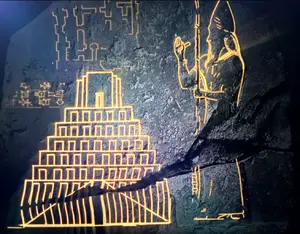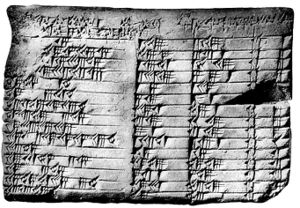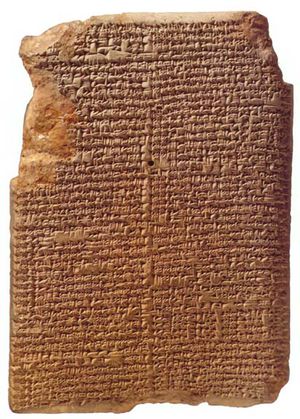Difference between revisions of "How Was Science Practiced in Ancient Babylon"
(Created page with "File: Etemenanki_Babylon_(3).png|300px|thumbnail|left|Relief of a Neo-Babylonian Ruler in front of the Etemenanki Ziggurat in Babylon: the Piece is Highlighted to Better Sho...") |
(No difference)
|
Revision as of 23:47, 10 September 2018
From about 2,000 BC until the early Hellenistic Period (ca. early third century BC), Babylon was one of the greatest cities in the ancient world. It was marked by political stability and military power under three of the most powerful political dynasties of the ancient Near East: the First Dynasty of Babylon (ca. 1894-1595 BC); the Kassite Dynasty (ca. 1374-1155 BC); and the Neo-Babylonian Dynasty (626-539 BC). These powerful dynasties often conquered their weaker neighbors and traded with the stronger ones, but they also nurtured scientific thought, some of which is still used today while other ideas have been discarded or changed dramatically.
Ancient Babylonian thinkers were especially excellent mathematicians, as they were the first people to use fractions, which they used to build advance siege weaponry and to parcel out the limited farmable land in their kingdom. The Babylonians were also among the earliest people to develop the study of astronomy and along with it astrology, which was considerably different for them than it is today. The ancient Babylonians were truly a people who understood scientific thinking, but their concept of science differed dramatically from the modern view, or even that of the Greeks, because all of their science was used for practical applications – there was no such thing as abstract science in ancient Babylonia.
Contents
Early Babylonian Culture
The ancient city of Babylon was located along the banks of the Euphrates river near the modern city of Baghdad in what is now the nation-state of Iraq. During ancient times the region between and near the Tigris and Euphrates rivers was known as Mesopotamia and the area around Babylon was referred to specifically as “Babylonia.” When the ethnic group known as the Sumerians first brought civilization to Mesopotamia around the year 3100 BC, the focal point of Mesopotamian civilization was around the southern Mesopotamian cities of Uruk and Ur. But as the Sumerians gradually faded from history in the late third millennium BC, the epicenter of Mesopotamian civilization shifted north to the city of Babylon. [1]
In the early second millennium BC, an ethnic group known as the Amorites emerged from the desert to conquer Babylon and establish the First Dynasty of Babylon. The Amorites adopted many of the cultural traits and tastes of the Sumerians to give Mesopotamian civilization a certain degree of continuity and some of their leaders proved to be especially well-suited for kingship. Hammurabi (ruled ca, 1792-1750) was the best known and most accomplished kings of the dynasty. Hammurabi conquered most of Mesopotamia and had commissioned the so-called “Law Code of Hammurabi,” but he also patronized institutions that fostered scientific thought. [2]
In Babylon, as was the case in every pre-modern society, religion and science were mingled to the point where it was often difficult, if not impossible to separate the two. The primary deity of Babylon was Marduk, who was associated with the planet known today as Jupiter. [3] Marduk was preeminent throughout the year, but during the New Year’s festival, known as Akitu in the Akkadian language, Babylonians from all classes were expected to honor the god of the fifth planet. The sacred cult statue of Marduk would be paraded by the priests to all of the temples before being placed in its restricted sanctuary for another year. [4] The mixture of religion and science would continue and become more pronounced in the later Babylonian dynasties.
Babylonian Math
In order to understand how the Babylonians used science, one must first understand how they viewed science. Mesopotamian science in general and Babylonian science specifically was extremely advanced in many ways, especially when one considers the science of contemporary civilizations, but it was devoid of any abstract reasoning such as theorems or proofs. [5] Essentially, Babylonian science was all practical and always used for the good of the state. For instance, advanced math was used to divide farmable land into plots that resulted in not only standard, rectangular parcels, but also triangular and even polygon plots of land. [6]
Fortunately, modern scholars know a great deal about Babylonian math because their calculating methods and multiplication tables were inscribed on clay tablets that have been preserved. [7] The tablets reveal that there was far more to Babylonian math than simple addition and subtraction.
Babylonian mathematical tablets show that not only did they use multiplication, but that their system counting was sexagesimal (based on sixty) and that they were the first people to use fractions. Their geometry was also advanced enough that they used the “Pythagorean Theorem” long before it was known as such. Despite having knowledge of how the Pythagorean Theorem functioned, they never abstracted the method by asking how it worked as the later Greeks did. [8]
Besides using their math to divide farming plots in their kingdom, the Babylonians were able to utilize equations to produce siege equipment and in other facets of warfare. Tablets from the First Dynasty of Babylon show students were schooled in calculations intended to divert rivers through cities in order to take down defensive walls. The math employed by Babylonian scholars was then later used by the Assyrians to invent siege engines that were truly ahead of their time. [9]
Babylonian Astronomy and Astrology
Today the Babylonians are perhaps best known for their astronomical observations, but astronomy and astrology played a subordinate role to mathematics for quite some time in Babylonian history. It was not until the end of the Kassite Dynasty when astronomy began to become the most important Babylonian science, which continued into the first millennium BC during the Neo-Babylonian Dynasty. It was then that Babylonian astronomers began mapping out constellations, dividing thirty-six into three circles represented by the gods Anu, Ellil, and Ea. [10]
Even more than mathematics, Babylonian astronomy represented the melding of science and religion. The planets were all associated with different deities and ziggurats in the city, and throughout all of Mesopotamia for that matter, served not only as temples, but also as scribal schools and celestial observatories. [11] Once the astronomers made their observations, they were able to develop calendars and make predictions for the good of the state.
The Babylonians were able to create calendars that were more accurate than those produced by their contemporaries because their calendrical observations were aided by advances in astronomy and math, which helped to iron out potential problems. For instance, the fact that connections between the day, month, and year could not be expressed in whole numbers was rectified by the Babylonians through their observations of the stars and use of math. They created a lunisolar calendar that was very adaptable, adding an extra month if needed to equalize the solar and lunar years. [12]
The astronomical observations the Babylonians made were later discovered by Jewish and Greek scholars, who used the knowledge to predict eclipses. The second century AD Alexandrian scientist, Ptolemy, and even the sixth century BC Greek philosopher and scientist Thales are believed to have accurately predicted eclipses based on Babylonian celestial observations. [13] The Greeks truly were impressed with Babylonian astronomy, especially during the Hellenistic Period when the Greek Seleucids controlled Babylon and were able to translate many of the cuneiform Akkadian tablets into Greek. But the Greeks were most interested in a Babylonian science that is not considered so today – astrology.
It is important to remember that all forms of science were used for the king and state in ancient Babylon, which also included astrology. For the Babylonians, astrology consisted of making temporal predictions and decisions based on the movements of the celestial bodies. After observing the planets and stars, Babylonian scientists would suggest to the king such things as when and where to plant crops, when to pursue diplomacy, and when to go to war. Unlike today, astrology was never used for personal decisions, unless it had to do with the king, and was viewed as part of astronomy, not separate from it. [14]
Conclusion
There is a common misconception among many people in the modern world that scientific thought began with the ancient Greeks, but an examination reveals that true science was being practiced centuries earlier in the Mesopotamian city of Babylon, albeit with some fundamental differences. The ancient Babylonians were the first people to use fractions, make advanced astronomical observations, and create one of the most accurate calendars of the ancient world. Still, the science practiced in ancient Babylon had some fundamental differences from modern or even Greek practices. The Babylonians never abstracted their science: they never questioned the processes and did not develop theorems or proofs for the mathematical formulas. Whether it was done for agriculture, diplomacy, or warfare, all Babylonian science was done for the benefit of the state. Finally, science and religion were tightly intertwined in ancient Babylon. Astronomical observations were made by priests in religious temples to make predictions for the king and state, which were sanctioned by the Mesopotamian deities.
References
- ↑ Kuhrt, Amélie. The Ancient Near East: c. 3000-330 BC. (London: Routledge, 2010), p. 108
- ↑ Kuhrt, p. 109
- ↑ Soden, Wolfram von. The Ancient Orient: An Introduction to the Study of the Ancient Near East. Translated by Donald G. Schley. (Grand Rapids, Michigan: William B. Eerdmans, 1994), p. 180
- ↑ Pritchard, James B, ed. Ancient Near Eastern Texts Relating to the Old Testament. 3rd ed. (Princeton, New Jersey: Princeton University Press, 1992), p. 390
- ↑ Soden, p. 146
- ↑ Soden, p. 165
- ↑ Stolper, Matthew W. “Literary, Ritual, and Mathematical Texts.” In The Royal City of Susa: Ancient Near Eastern Treasures in the Louvre. Edited by Prudence O. Harper, Joan Aruz, and François Tallon. (New York: Metropolitan Museum of Art, 1993), pgs. 72
- ↑ Soden, pgs. 166-8
- ↑ Soden, p. 85
- ↑ Soden, p. 169
- ↑ Frankfort, Henri. The Art and Architecture of the Ancient Orient. (New Haven, Connecticut: Yale University Press, 1996), p. 20
- ↑ Soden, p. 171
- ↑ Soden, p. 170
- ↑ Sachs, A. “Babylonian Horoscopes.” Journal of Cuneiform Studies. 6 (1952) p. 50


